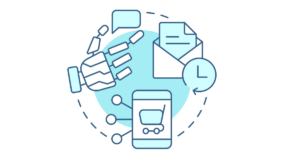The power to keep customers and clients on your side rests in your email lists. But those lists will only help you build customer loyalty and drive revenue if you put them to work.
It doesn’t matter what line of business you are in, how good your products or services are, or how well you deliver on your promises; customers can be a fickle bunch. If you don’t keep them engaged between projects or purchases, they can quickly have their heads turned by a competitive offer.
Throughout this article, we’ll examine how your business can better utilize your email lists to ensure your hard-won clients keep coming back for more.
The Role Email Lists Can Play In Your Business
Your email lists represent so much more than just a collection of individuals’ contact details. Email marketing is a permission-based marketing strategy. This means that people have not only taken the time to give you information about themselves, they have actually given you permission to contact them with relevant marketing messages.
In the past, this permission may have been passively surrendered when making a purchase or registering for a service. However, as global privacy regulations like GDPR have clamped down on how marketers collect and store contact information, your subscribers now have more power than ever when it comes to controlling whose emails they would like to see in their inbox
Make no mistake. Your email marketing subscribers are potentially more engaged with your business than any of your other digital audiences. Wise marketers will take full advantage of the opportunities that email marketing present in generating low-life and low-cost revenue and engagement.
Benefits of Creating an Email List
Email marketing isn’t just about newsletters. Your email marketing lists provide the perfect opportunity to share incredibly potent marketing content with your most engaged customers and prospects. This includes:
- Upsell Opportunities: Promoting products or services to complement existing purchases. For example, an airline may wish to offer its passengers a seat upgrade, pre-booked in-flight meal, or onward travel-related services such as a rental car, hotel booking, or travel insurance.
- New Product/Service Launches: Even the most loyal customer can be forgiven for going to a competitor if they don’t know your business offers a particular product or service. When you ensure the people on your email lists are among the first to know about new products and services, you’ll be rewarded with deeper relationships.
- Reputation Enhancing Thought Leadership: Nothing will enhance your brand reputation faster than some solid expert-led content delivered via your blog, eBooks, webinars, etc. But there’s little point in creating thought-leadership content if nobody reads it. Email marketing can help you place that content in the hands of the people that matter most to your business —your customers.
- Marketing Events: Summer sales, 2-for-1 offers, free shipping, etc. Though marketing teams should be careful about offering superfluous discounts—who doesn’t love a good deal? Marketing events are an excellent opportunity to clear unsold inventory, fill order books during slow sales periods, and keep the cash coming in.
But email marketing isn’t just a fantastic content delivery system. It can actually save you money.
Retention Marketing
Most forms of digital marketing, including paid search, paid social, SEO, etc., are acquisition marketing channels. Email marketing, however, is also a retention marketing channel. As anyone who has been in business for any length of time will tell you, it is always more expensive to acquire a customer than to retain one. It is not unusual for a business to lose money on the initial sales generated by an acquisition campaign. Instead, profits are delivered further down the line thanks to low-cost retention marketing strategies generating greater Customer Lifetime Value (CLV). This means three things:
- Good email marketing can be the most profitable component of everything else you do to promote your business.
- If you don’t engage in email marketing along with your various acquisition marketing strategies, it becomes increasingly challenging to see a positive return on investment from your marketing spend.
- Email marketing and list growth should be considered as crucial parts of your complete marketing strategy.
3 Steps to Creating a Robust Email List
Once you’ve realized that email marketing plays a vital role in your digital marketing ecosystem, you’ll want to prioritize building your email lists. But before you start collecting subscribers’ contact details, you’ll need to do some groundwork. This process begins with the following three steps:
- Set Your Objectives: What exactly do you want to do with your email lists? Do you just want to send an occasional email newsletter to a group of subscribers? Or are you looking at something more sophisticated in terms of list segmentation and campaign automation? If you are looking for inspiration, we’ve written extensively on this blog about the various campaign strategies you can deploy beyond the newsletter. Remember, if you don’t have an objective, you’ll find it challenging to create a strategy that helps you reach any goal.
- Check Your Resources: What resources already exist in your organization to help you achieve your objectives? How are you managing customer data in your existing MarTech stack, including your eCommerce, CRM, and financial systems? Do you have the human resources available to execute your strategy and create engaging content to attract people to join your email lists and deliver as campaigns?
- Select Your Technology: Email marketing is not something that can be managed with a spreadsheet and everyday email client like Outlook or Gmail. You’ll need an email marketing platform that not only helps you build and manage your email lists efficiently and effectively but does so in compliance with global privacy regulations like GDPR, CCPA/CPRA, etc. Of course, a great email marketing platform won’t just help you manage your lists. It will help you design and personalize your email marketing campaigns, schedule or automate delivery, guarantee high levels of inbox placement, provide detailed analytics, and integrate with your existing MarTech stack.
8 Strategies for Growing Your Email List
List growth is vital because email addresses often have a limited shelf life. People change jobs, move service providers, close down old addresses, and sadly nobody lives forever. Your list growth needs to outpace list churn, which may run as high as 30% per year.
Email list growth isn’t a passive activity. It’s not enough to include a newsletter subscription form on your website’s homepage in the hope people will join your lists. Your email lists need to be actively promoted to your potential subscribers by offering real value.
So how can you actively promote email list growth while counterbalancing the threat of attrition? The following eight strategies will help you stay ahead of the game:
- Newsletter Subscription Forms: Newsletter subscription forms still hold incredible value. But you need to make sure these work harder for you than if they were just placed on your homepage. Your forms should be placed in a prominent position on every page of your website, such as in the sidebar, header, footer, or as a pop-up. From a design point of view, the form should be highly visible and offer a simple call to action highlighting the benefits of a subscription. Don’t ask for too much information from your potential subscribers. An email address is enough data for you to start building a long-term relationship.
- Create Lead Magnets: Lead magnets are valuable pieces of content offered in exchange for an email address. This could be an eBook, checklist, template, whitepaper, webinar replay, or any other digital resource that your audience would find helpful.
- Competitions and Giveaways: Running competitions and giveaways where participants can enter by signing up for your email list is a great way to grow your list. To maximize the visibility of your promotions, you should promote the campaign heavily on social media, your website, and potentially through paid advertising.
- Online Events: Hosting webinars or online events on topics relevant to your audience that require attendees to register with their email addresses provides an excellent opportunity to add them to your email list.
- Offline Events: If you participate in trade shows, conferences, or other offline events, you can collect email addresses from interested individuals and add them to your email list. Use paper sign-up sheets, QR codes, or tablets for convenient opt-ins.
- eCommerce Checkout: If you run an eCommerce store, include an option for customers to opt into your email list during the checkout process. Offer exclusive discounts or future product updates as an incentive.
- Retail/Trade Counters: If you operate a retail business or trade counter, asking your in-person customers for their email addresses is a great way to build out your list. Offering them an incentive, such as a discount coupon on their next purchase or even just an electronic copy of their receipt, is a great incentive.
- Exit-Intent Pop-Ups: These are pop-up forms that trigger when a user is about to leave your website. Offer a compelling reason to stay, such as joining your email list to receive a discount code or access to exclusive content.
Learn More
To learn more about how your business can build more profitable relationships and grow your email list using the emfluence Marketing Platform, schedule a product demonstration with one of our email and marketing automation experts here.


